Challenges in Training for Take Home Naloxone
VerifiedAdded on 2023/06/03
|8
|1779
|236
AI Summary
This article discusses the challenges faced in training for take home naloxone program, including workforce and community challenges. It also suggests effective strategies for implementation.
Contribute Materials
Your contribution can guide someone’s learning journey. Share your
documents today.
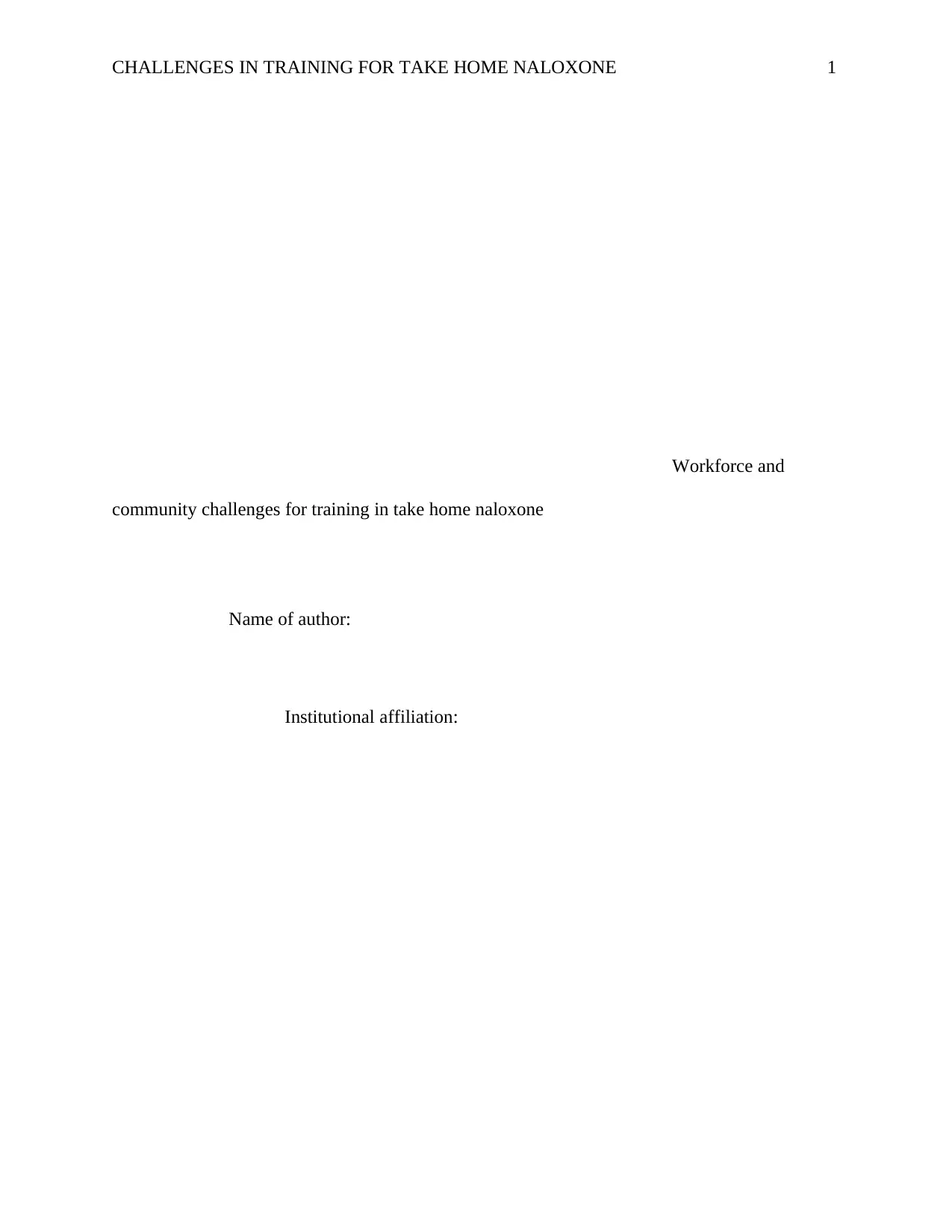
CHALLENGES IN TRAINING FOR TAKE HOME NALOXONE 1
Workforce and
community challenges for training in take home naloxone
Name of author:
Institutional affiliation:
Workforce and
community challenges for training in take home naloxone
Name of author:
Institutional affiliation:
Secure Best Marks with AI Grader
Need help grading? Try our AI Grader for instant feedback on your assignments.
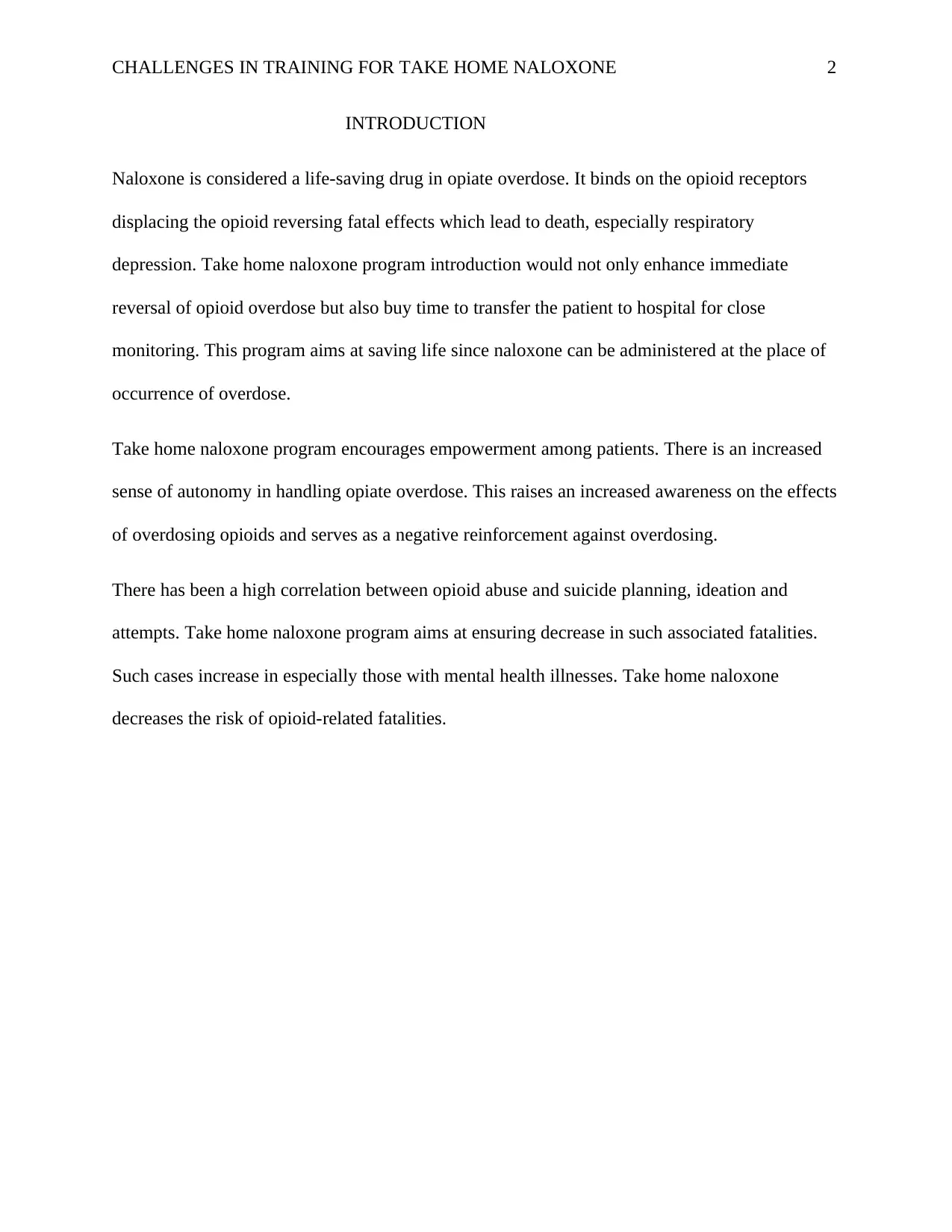
CHALLENGES IN TRAINING FOR TAKE HOME NALOXONE 2
INTRODUCTION
Naloxone is considered a life-saving drug in opiate overdose. It binds on the opioid receptors
displacing the opioid reversing fatal effects which lead to death, especially respiratory
depression. Take home naloxone program introduction would not only enhance immediate
reversal of opioid overdose but also buy time to transfer the patient to hospital for close
monitoring. This program aims at saving life since naloxone can be administered at the place of
occurrence of overdose.
Take home naloxone program encourages empowerment among patients. There is an increased
sense of autonomy in handling opiate overdose. This raises an increased awareness on the effects
of overdosing opioids and serves as a negative reinforcement against overdosing.
There has been a high correlation between opioid abuse and suicide planning, ideation and
attempts. Take home naloxone program aims at ensuring decrease in such associated fatalities.
Such cases increase in especially those with mental health illnesses. Take home naloxone
decreases the risk of opioid-related fatalities.
INTRODUCTION
Naloxone is considered a life-saving drug in opiate overdose. It binds on the opioid receptors
displacing the opioid reversing fatal effects which lead to death, especially respiratory
depression. Take home naloxone program introduction would not only enhance immediate
reversal of opioid overdose but also buy time to transfer the patient to hospital for close
monitoring. This program aims at saving life since naloxone can be administered at the place of
occurrence of overdose.
Take home naloxone program encourages empowerment among patients. There is an increased
sense of autonomy in handling opiate overdose. This raises an increased awareness on the effects
of overdosing opioids and serves as a negative reinforcement against overdosing.
There has been a high correlation between opioid abuse and suicide planning, ideation and
attempts. Take home naloxone program aims at ensuring decrease in such associated fatalities.
Such cases increase in especially those with mental health illnesses. Take home naloxone
decreases the risk of opioid-related fatalities.
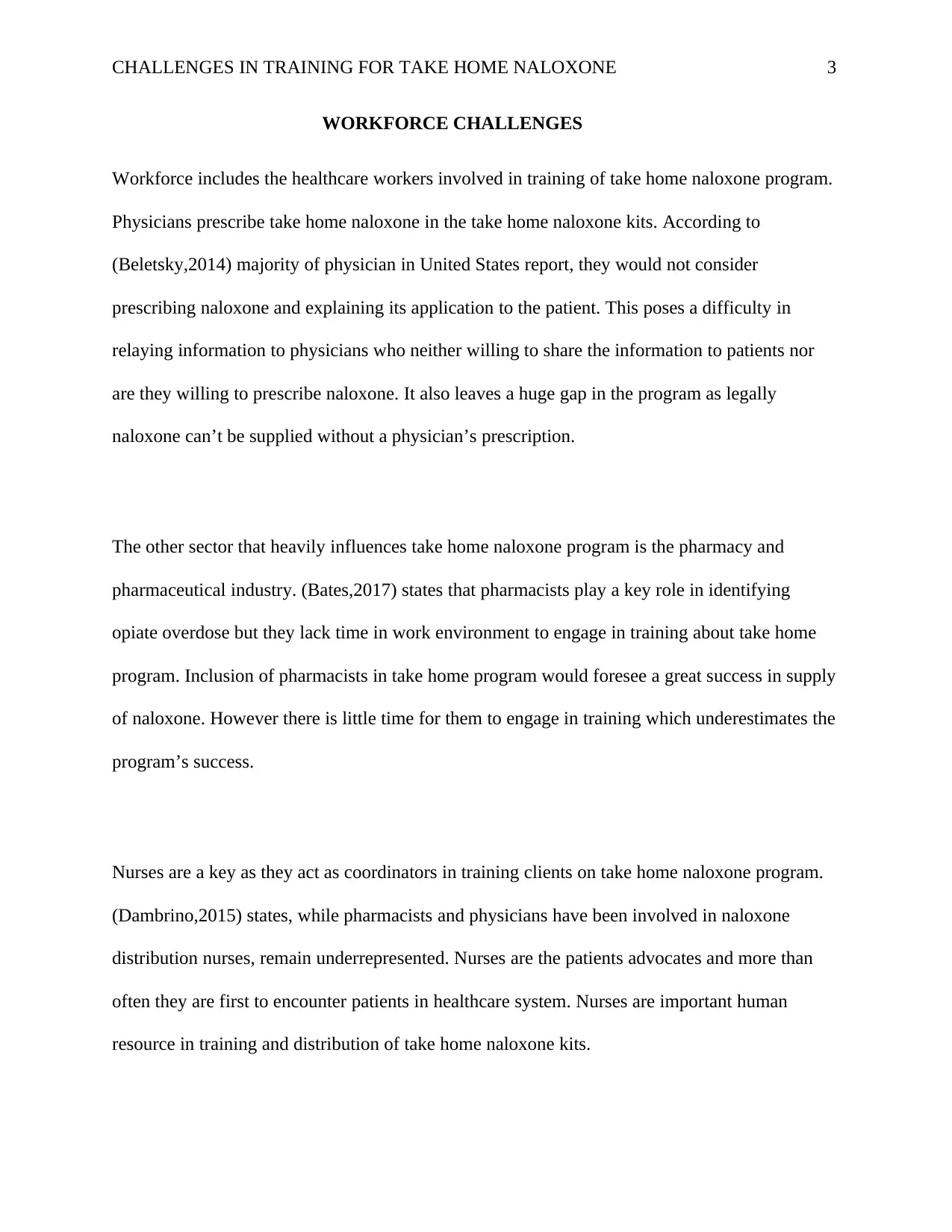
CHALLENGES IN TRAINING FOR TAKE HOME NALOXONE 3
WORKFORCE CHALLENGES
Workforce includes the healthcare workers involved in training of take home naloxone program.
Physicians prescribe take home naloxone in the take home naloxone kits. According to
(Beletsky,2014) majority of physician in United States report, they would not consider
prescribing naloxone and explaining its application to the patient. This poses a difficulty in
relaying information to physicians who neither willing to share the information to patients nor
are they willing to prescribe naloxone. It also leaves a huge gap in the program as legally
naloxone can’t be supplied without a physician’s prescription.
The other sector that heavily influences take home naloxone program is the pharmacy and
pharmaceutical industry. (Bates,2017) states that pharmacists play a key role in identifying
opiate overdose but they lack time in work environment to engage in training about take home
program. Inclusion of pharmacists in take home program would foresee a great success in supply
of naloxone. However there is little time for them to engage in training which underestimates the
program’s success.
Nurses are a key as they act as coordinators in training clients on take home naloxone program.
(Dambrino,2015) states, while pharmacists and physicians have been involved in naloxone
distribution nurses, remain underrepresented. Nurses are the patients advocates and more than
often they are first to encounter patients in healthcare system. Nurses are important human
resource in training and distribution of take home naloxone kits.
WORKFORCE CHALLENGES
Workforce includes the healthcare workers involved in training of take home naloxone program.
Physicians prescribe take home naloxone in the take home naloxone kits. According to
(Beletsky,2014) majority of physician in United States report, they would not consider
prescribing naloxone and explaining its application to the patient. This poses a difficulty in
relaying information to physicians who neither willing to share the information to patients nor
are they willing to prescribe naloxone. It also leaves a huge gap in the program as legally
naloxone can’t be supplied without a physician’s prescription.
The other sector that heavily influences take home naloxone program is the pharmacy and
pharmaceutical industry. (Bates,2017) states that pharmacists play a key role in identifying
opiate overdose but they lack time in work environment to engage in training about take home
program. Inclusion of pharmacists in take home program would foresee a great success in supply
of naloxone. However there is little time for them to engage in training which underestimates the
program’s success.
Nurses are a key as they act as coordinators in training clients on take home naloxone program.
(Dambrino,2015) states, while pharmacists and physicians have been involved in naloxone
distribution nurses, remain underrepresented. Nurses are the patients advocates and more than
often they are first to encounter patients in healthcare system. Nurses are important human
resource in training and distribution of take home naloxone kits.
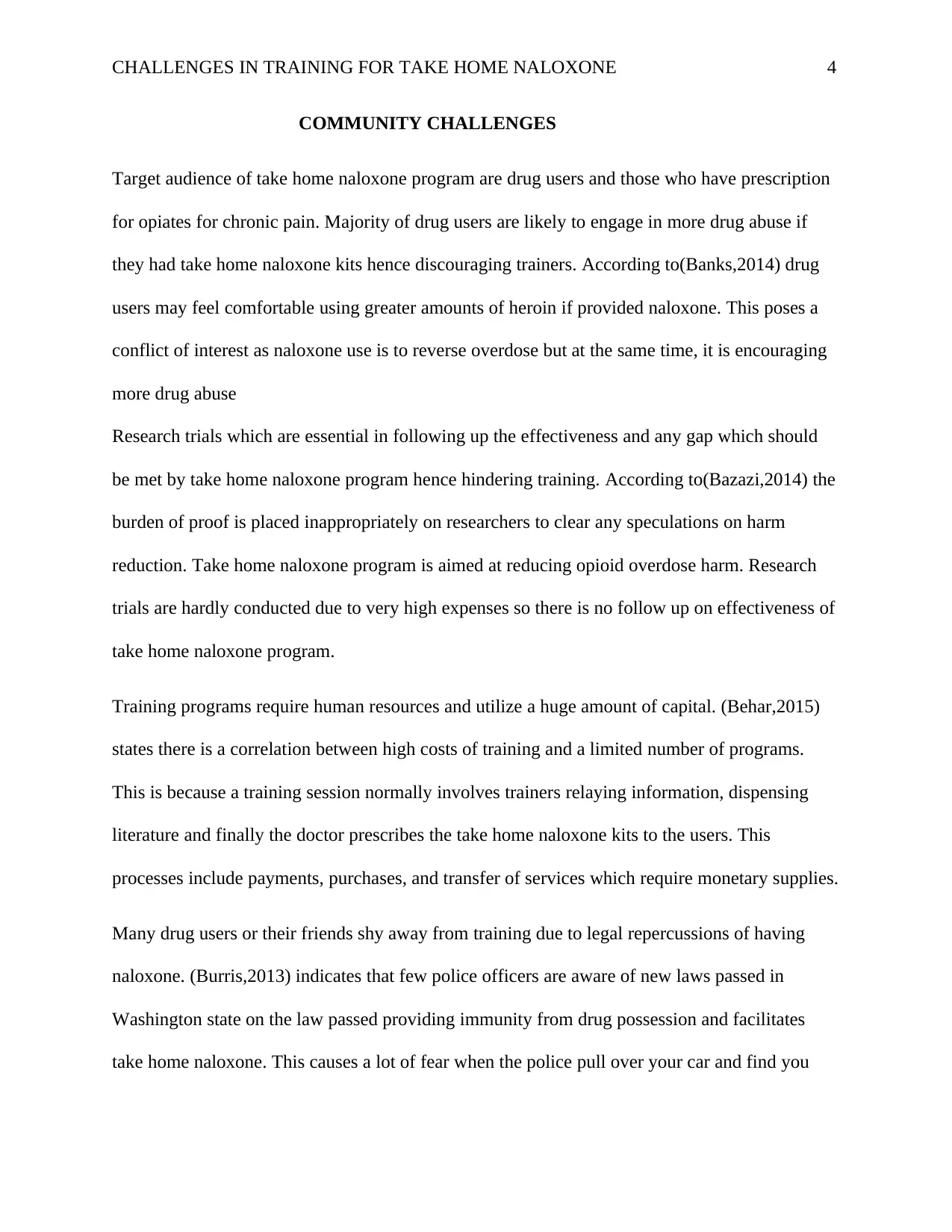
CHALLENGES IN TRAINING FOR TAKE HOME NALOXONE 4
COMMUNITY CHALLENGES
Target audience of take home naloxone program are drug users and those who have prescription
for opiates for chronic pain. Majority of drug users are likely to engage in more drug abuse if
they had take home naloxone kits hence discouraging trainers. According to(Banks,2014) drug
users may feel comfortable using greater amounts of heroin if provided naloxone. This poses a
conflict of interest as naloxone use is to reverse overdose but at the same time, it is encouraging
more drug abuse
Research trials which are essential in following up the effectiveness and any gap which should
be met by take home naloxone program hence hindering training. According to(Bazazi,2014) the
burden of proof is placed inappropriately on researchers to clear any speculations on harm
reduction. Take home naloxone program is aimed at reducing opioid overdose harm. Research
trials are hardly conducted due to very high expenses so there is no follow up on effectiveness of
take home naloxone program.
Training programs require human resources and utilize a huge amount of capital. (Behar,2015)
states there is a correlation between high costs of training and a limited number of programs.
This is because a training session normally involves trainers relaying information, dispensing
literature and finally the doctor prescribes the take home naloxone kits to the users. This
processes include payments, purchases, and transfer of services which require monetary supplies.
Many drug users or their friends shy away from training due to legal repercussions of having
naloxone. (Burris,2013) indicates that few police officers are aware of new laws passed in
Washington state on the law passed providing immunity from drug possession and facilitates
take home naloxone. This causes a lot of fear when the police pull over your car and find you
COMMUNITY CHALLENGES
Target audience of take home naloxone program are drug users and those who have prescription
for opiates for chronic pain. Majority of drug users are likely to engage in more drug abuse if
they had take home naloxone kits hence discouraging trainers. According to(Banks,2014) drug
users may feel comfortable using greater amounts of heroin if provided naloxone. This poses a
conflict of interest as naloxone use is to reverse overdose but at the same time, it is encouraging
more drug abuse
Research trials which are essential in following up the effectiveness and any gap which should
be met by take home naloxone program hence hindering training. According to(Bazazi,2014) the
burden of proof is placed inappropriately on researchers to clear any speculations on harm
reduction. Take home naloxone program is aimed at reducing opioid overdose harm. Research
trials are hardly conducted due to very high expenses so there is no follow up on effectiveness of
take home naloxone program.
Training programs require human resources and utilize a huge amount of capital. (Behar,2015)
states there is a correlation between high costs of training and a limited number of programs.
This is because a training session normally involves trainers relaying information, dispensing
literature and finally the doctor prescribes the take home naloxone kits to the users. This
processes include payments, purchases, and transfer of services which require monetary supplies.
Many drug users or their friends shy away from training due to legal repercussions of having
naloxone. (Burris,2013) indicates that few police officers are aware of new laws passed in
Washington state on the law passed providing immunity from drug possession and facilitates
take home naloxone. This causes a lot of fear when the police pull over your car and find you
Secure Best Marks with AI Grader
Need help grading? Try our AI Grader for instant feedback on your assignments.
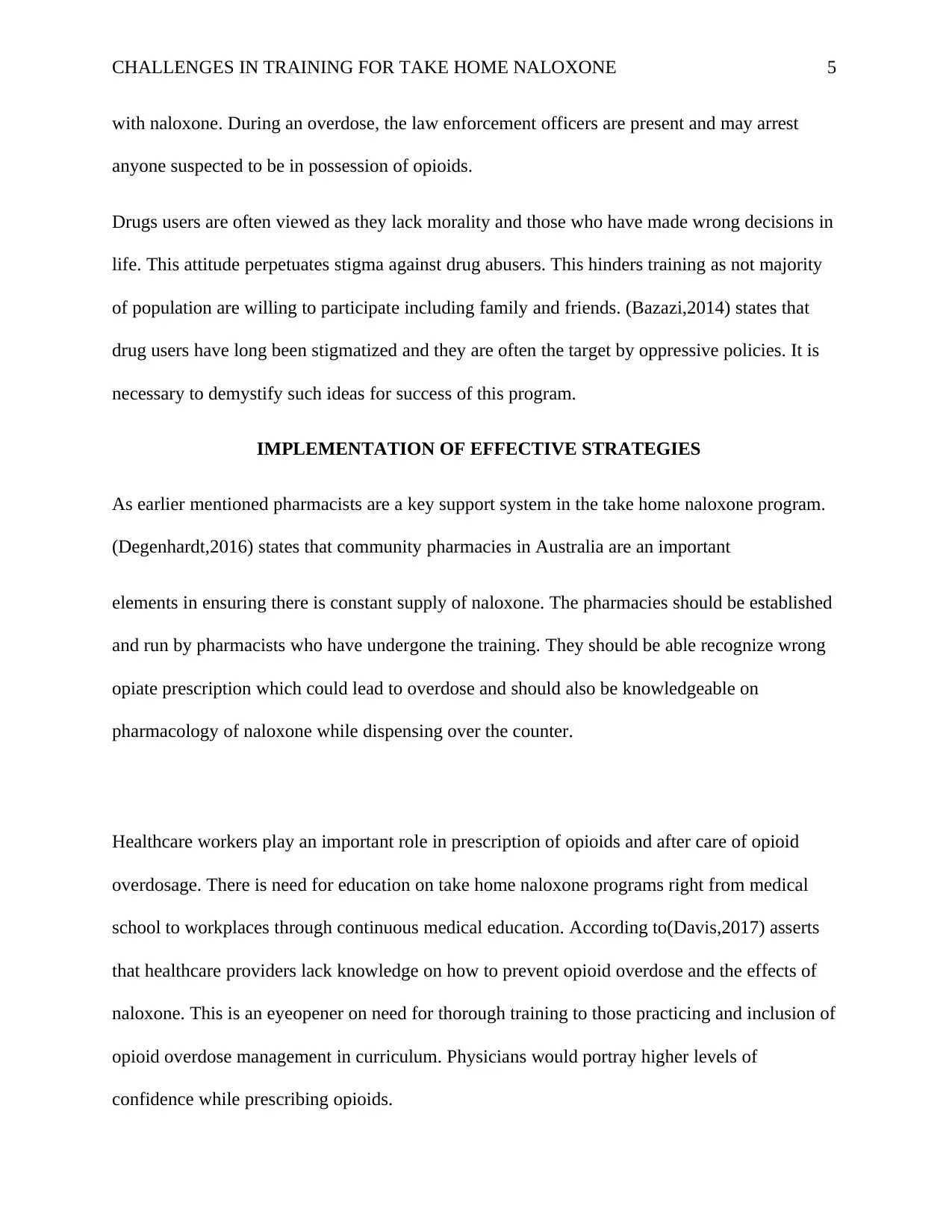
CHALLENGES IN TRAINING FOR TAKE HOME NALOXONE 5
with naloxone. During an overdose, the law enforcement officers are present and may arrest
anyone suspected to be in possession of opioids.
Drugs users are often viewed as they lack morality and those who have made wrong decisions in
life. This attitude perpetuates stigma against drug abusers. This hinders training as not majority
of population are willing to participate including family and friends. (Bazazi,2014) states that
drug users have long been stigmatized and they are often the target by oppressive policies. It is
necessary to demystify such ideas for success of this program.
IMPLEMENTATION OF EFFECTIVE STRATEGIES
As earlier mentioned pharmacists are a key support system in the take home naloxone program.
(Degenhardt,2016) states that community pharmacies in Australia are an important
elements in ensuring there is constant supply of naloxone. The pharmacies should be established
and run by pharmacists who have undergone the training. They should be able recognize wrong
opiate prescription which could lead to overdose and should also be knowledgeable on
pharmacology of naloxone while dispensing over the counter.
Healthcare workers play an important role in prescription of opioids and after care of opioid
overdosage. There is need for education on take home naloxone programs right from medical
school to workplaces through continuous medical education. According to(Davis,2017) asserts
that healthcare providers lack knowledge on how to prevent opioid overdose and the effects of
naloxone. This is an eyeopener on need for thorough training to those practicing and inclusion of
opioid overdose management in curriculum. Physicians would portray higher levels of
confidence while prescribing opioids.
with naloxone. During an overdose, the law enforcement officers are present and may arrest
anyone suspected to be in possession of opioids.
Drugs users are often viewed as they lack morality and those who have made wrong decisions in
life. This attitude perpetuates stigma against drug abusers. This hinders training as not majority
of population are willing to participate including family and friends. (Bazazi,2014) states that
drug users have long been stigmatized and they are often the target by oppressive policies. It is
necessary to demystify such ideas for success of this program.
IMPLEMENTATION OF EFFECTIVE STRATEGIES
As earlier mentioned pharmacists are a key support system in the take home naloxone program.
(Degenhardt,2016) states that community pharmacies in Australia are an important
elements in ensuring there is constant supply of naloxone. The pharmacies should be established
and run by pharmacists who have undergone the training. They should be able recognize wrong
opiate prescription which could lead to overdose and should also be knowledgeable on
pharmacology of naloxone while dispensing over the counter.
Healthcare workers play an important role in prescription of opioids and after care of opioid
overdosage. There is need for education on take home naloxone programs right from medical
school to workplaces through continuous medical education. According to(Davis,2017) asserts
that healthcare providers lack knowledge on how to prevent opioid overdose and the effects of
naloxone. This is an eyeopener on need for thorough training to those practicing and inclusion of
opioid overdose management in curriculum. Physicians would portray higher levels of
confidence while prescribing opioids.
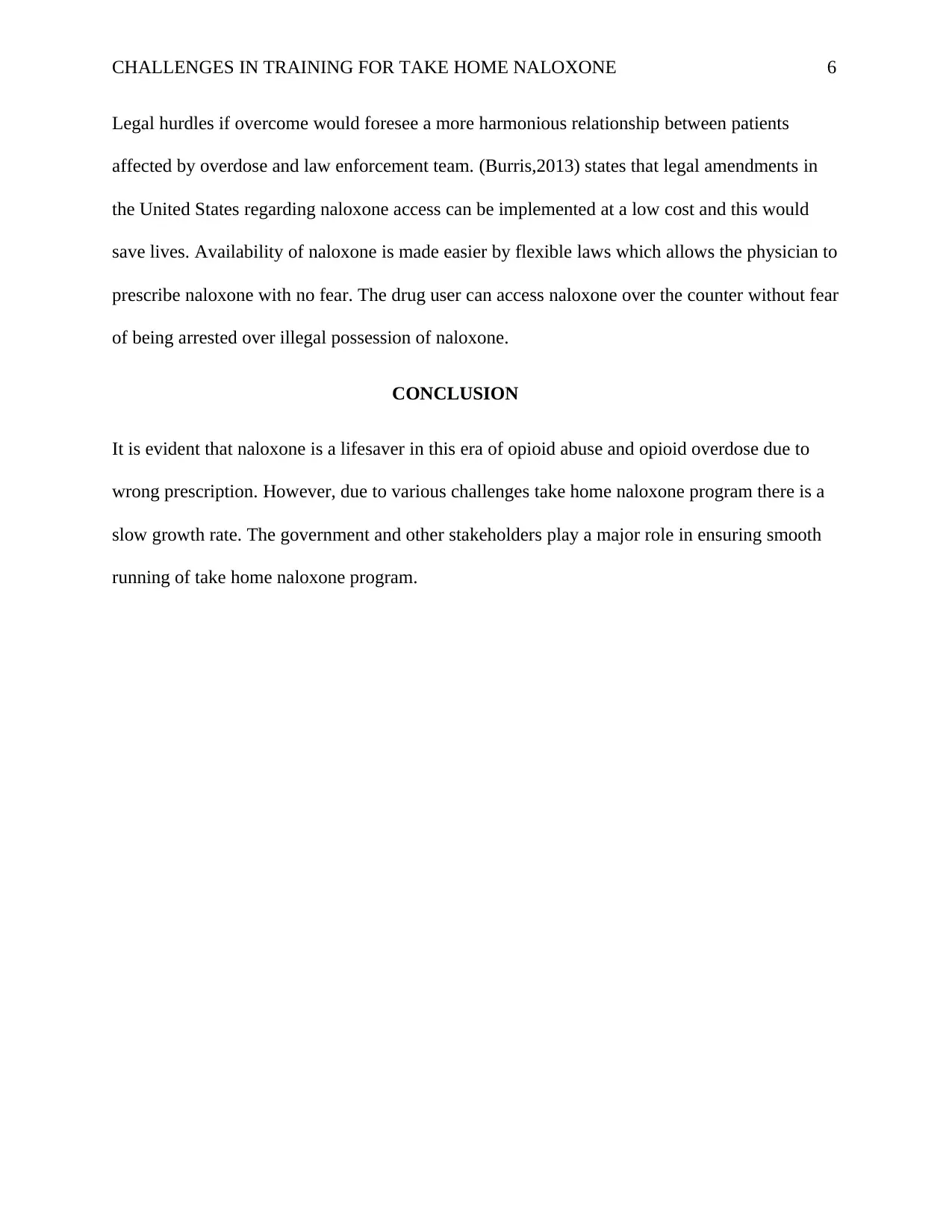
CHALLENGES IN TRAINING FOR TAKE HOME NALOXONE 6
Legal hurdles if overcome would foresee a more harmonious relationship between patients
affected by overdose and law enforcement team. (Burris,2013) states that legal amendments in
the United States regarding naloxone access can be implemented at a low cost and this would
save lives. Availability of naloxone is made easier by flexible laws which allows the physician to
prescribe naloxone with no fear. The drug user can access naloxone over the counter without fear
of being arrested over illegal possession of naloxone.
CONCLUSION
It is evident that naloxone is a lifesaver in this era of opioid abuse and opioid overdose due to
wrong prescription. However, due to various challenges take home naloxone program there is a
slow growth rate. The government and other stakeholders play a major role in ensuring smooth
running of take home naloxone program.
Legal hurdles if overcome would foresee a more harmonious relationship between patients
affected by overdose and law enforcement team. (Burris,2013) states that legal amendments in
the United States regarding naloxone access can be implemented at a low cost and this would
save lives. Availability of naloxone is made easier by flexible laws which allows the physician to
prescribe naloxone with no fear. The drug user can access naloxone over the counter without fear
of being arrested over illegal possession of naloxone.
CONCLUSION
It is evident that naloxone is a lifesaver in this era of opioid abuse and opioid overdose due to
wrong prescription. However, due to various challenges take home naloxone program there is a
slow growth rate. The government and other stakeholders play a major role in ensuring smooth
running of take home naloxone program.
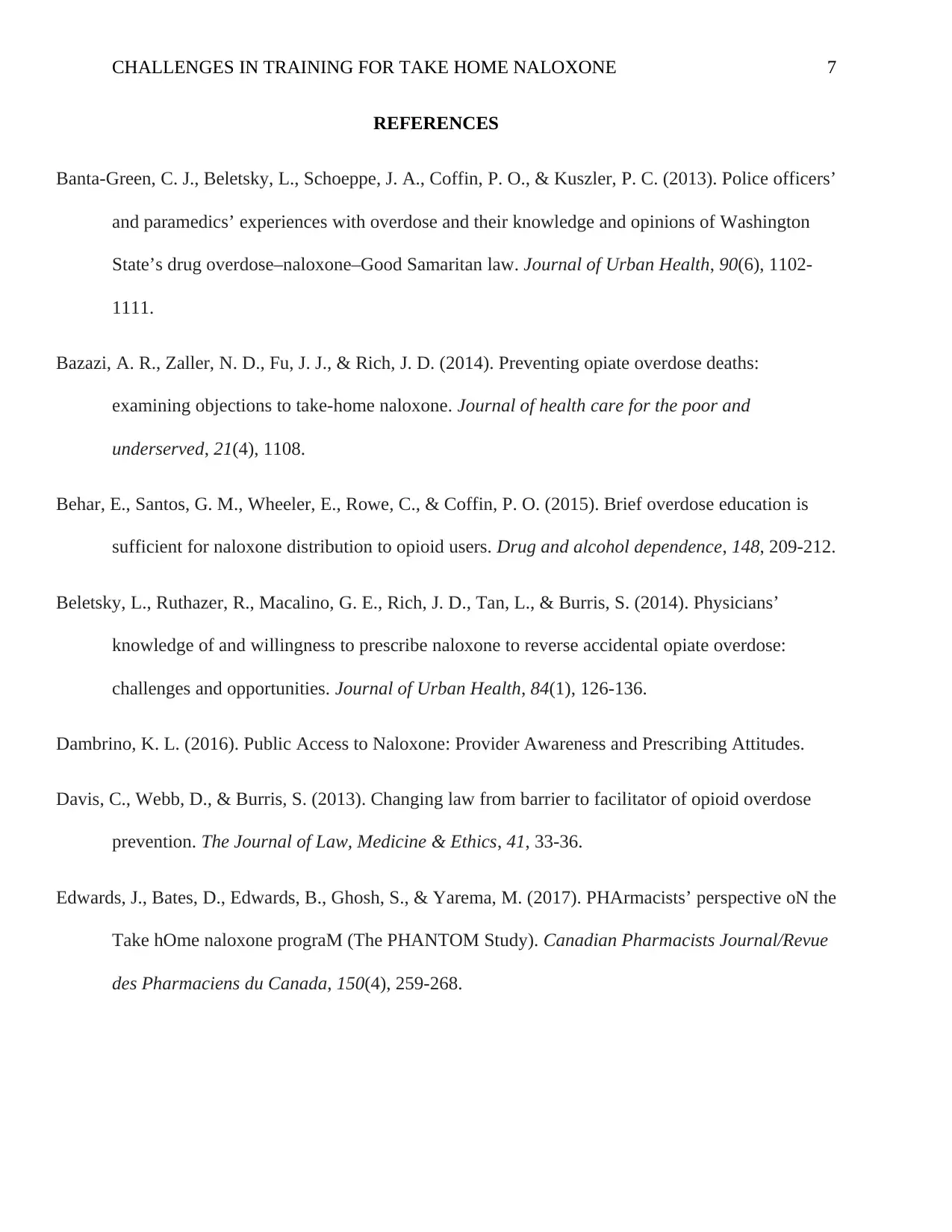
CHALLENGES IN TRAINING FOR TAKE HOME NALOXONE 7
REFERENCES
Banta-Green, C. J., Beletsky, L., Schoeppe, J. A., Coffin, P. O., & Kuszler, P. C. (2013). Police officers’
and paramedics’ experiences with overdose and their knowledge and opinions of Washington
State’s drug overdose–naloxone–Good Samaritan law. Journal of Urban Health, 90(6), 1102-
1111.
Bazazi, A. R., Zaller, N. D., Fu, J. J., & Rich, J. D. (2014). Preventing opiate overdose deaths:
examining objections to take-home naloxone. Journal of health care for the poor and
underserved, 21(4), 1108.
Behar, E., Santos, G. M., Wheeler, E., Rowe, C., & Coffin, P. O. (2015). Brief overdose education is
sufficient for naloxone distribution to opioid users. Drug and alcohol dependence, 148, 209-212.
Beletsky, L., Ruthazer, R., Macalino, G. E., Rich, J. D., Tan, L., & Burris, S. (2014). Physicians’
knowledge of and willingness to prescribe naloxone to reverse accidental opiate overdose:
challenges and opportunities. Journal of Urban Health, 84(1), 126-136.
Dambrino, K. L. (2016). Public Access to Naloxone: Provider Awareness and Prescribing Attitudes.
Davis, C., Webb, D., & Burris, S. (2013). Changing law from barrier to facilitator of opioid overdose
prevention. The Journal of Law, Medicine & Ethics, 41, 33-36.
Edwards, J., Bates, D., Edwards, B., Ghosh, S., & Yarema, M. (2017). PHArmacists’ perspective oN the
Take hOme naloxone prograM (The PHANTOM Study). Canadian Pharmacists Journal/Revue
des Pharmaciens du Canada, 150(4), 259-268.
REFERENCES
Banta-Green, C. J., Beletsky, L., Schoeppe, J. A., Coffin, P. O., & Kuszler, P. C. (2013). Police officers’
and paramedics’ experiences with overdose and their knowledge and opinions of Washington
State’s drug overdose–naloxone–Good Samaritan law. Journal of Urban Health, 90(6), 1102-
1111.
Bazazi, A. R., Zaller, N. D., Fu, J. J., & Rich, J. D. (2014). Preventing opiate overdose deaths:
examining objections to take-home naloxone. Journal of health care for the poor and
underserved, 21(4), 1108.
Behar, E., Santos, G. M., Wheeler, E., Rowe, C., & Coffin, P. O. (2015). Brief overdose education is
sufficient for naloxone distribution to opioid users. Drug and alcohol dependence, 148, 209-212.
Beletsky, L., Ruthazer, R., Macalino, G. E., Rich, J. D., Tan, L., & Burris, S. (2014). Physicians’
knowledge of and willingness to prescribe naloxone to reverse accidental opiate overdose:
challenges and opportunities. Journal of Urban Health, 84(1), 126-136.
Dambrino, K. L. (2016). Public Access to Naloxone: Provider Awareness and Prescribing Attitudes.
Davis, C., Webb, D., & Burris, S. (2013). Changing law from barrier to facilitator of opioid overdose
prevention. The Journal of Law, Medicine & Ethics, 41, 33-36.
Edwards, J., Bates, D., Edwards, B., Ghosh, S., & Yarema, M. (2017). PHArmacists’ perspective oN the
Take hOme naloxone prograM (The PHANTOM Study). Canadian Pharmacists Journal/Revue
des Pharmaciens du Canada, 150(4), 259-268.
Paraphrase This Document
Need a fresh take? Get an instant paraphrase of this document with our AI Paraphraser
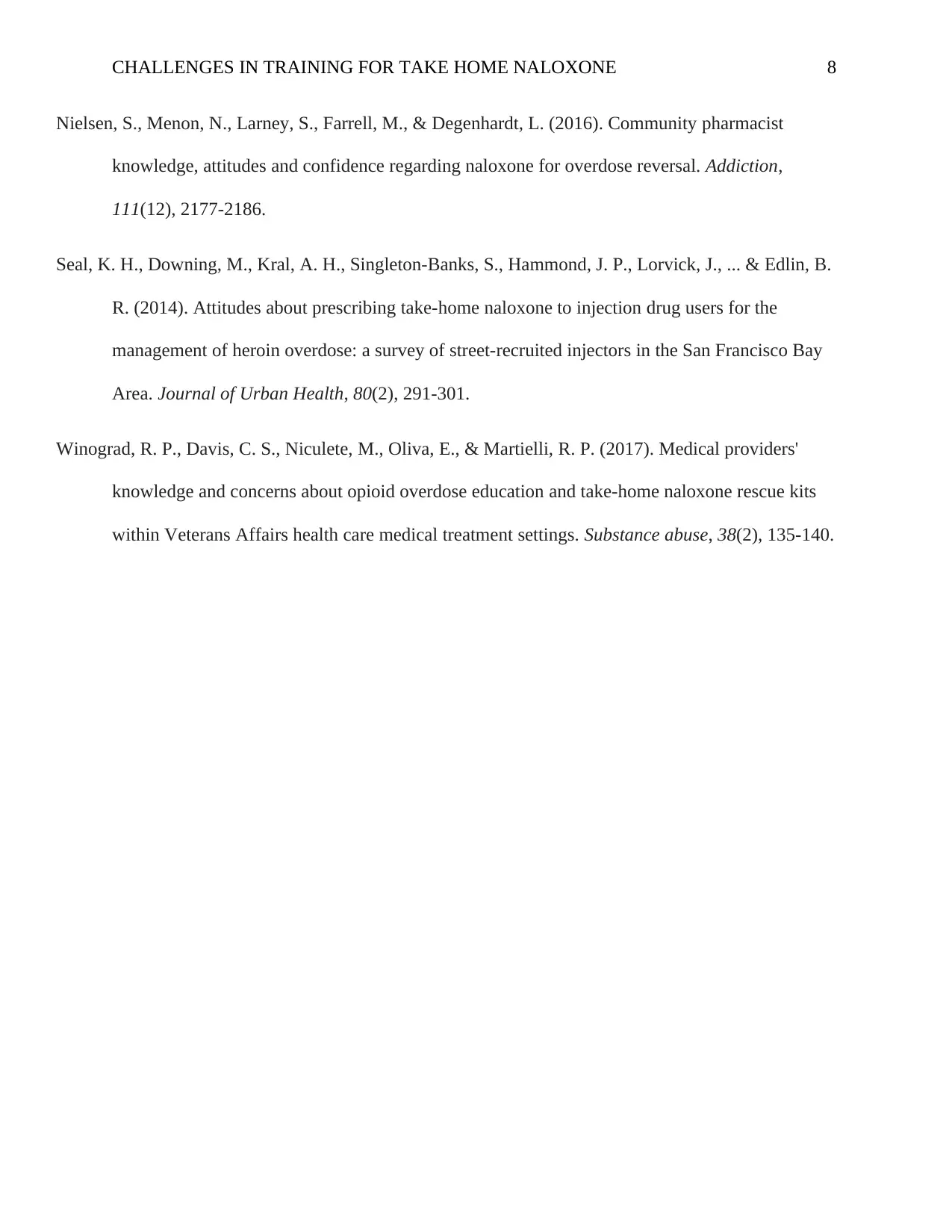
CHALLENGES IN TRAINING FOR TAKE HOME NALOXONE 8
Nielsen, S., Menon, N., Larney, S., Farrell, M., & Degenhardt, L. (2016). Community pharmacist
knowledge, attitudes and confidence regarding naloxone for overdose reversal. Addiction,
111(12), 2177-2186.
Seal, K. H., Downing, M., Kral, A. H., Singleton-Banks, S., Hammond, J. P., Lorvick, J., ... & Edlin, B.
R. (2014). Attitudes about prescribing take-home naloxone to injection drug users for the
management of heroin overdose: a survey of street-recruited injectors in the San Francisco Bay
Area. Journal of Urban Health, 80(2), 291-301.
Winograd, R. P., Davis, C. S., Niculete, M., Oliva, E., & Martielli, R. P. (2017). Medical providers'
knowledge and concerns about opioid overdose education and take-home naloxone rescue kits
within Veterans Affairs health care medical treatment settings. Substance abuse, 38(2), 135-140.
Nielsen, S., Menon, N., Larney, S., Farrell, M., & Degenhardt, L. (2016). Community pharmacist
knowledge, attitudes and confidence regarding naloxone for overdose reversal. Addiction,
111(12), 2177-2186.
Seal, K. H., Downing, M., Kral, A. H., Singleton-Banks, S., Hammond, J. P., Lorvick, J., ... & Edlin, B.
R. (2014). Attitudes about prescribing take-home naloxone to injection drug users for the
management of heroin overdose: a survey of street-recruited injectors in the San Francisco Bay
Area. Journal of Urban Health, 80(2), 291-301.
Winograd, R. P., Davis, C. S., Niculete, M., Oliva, E., & Martielli, R. P. (2017). Medical providers'
knowledge and concerns about opioid overdose education and take-home naloxone rescue kits
within Veterans Affairs health care medical treatment settings. Substance abuse, 38(2), 135-140.
1 out of 8
Your All-in-One AI-Powered Toolkit for Academic Success.
+13062052269
info@desklib.com
Available 24*7 on WhatsApp / Email
![[object Object]](/_next/static/media/star-bottom.7253800d.svg)
Unlock your academic potential
© 2024 | Zucol Services PVT LTD | All rights reserved.


